2014 MITSUBISHI LANCER SPORTBACK seats
[x] Cancel search: seatsPage 33 of 422
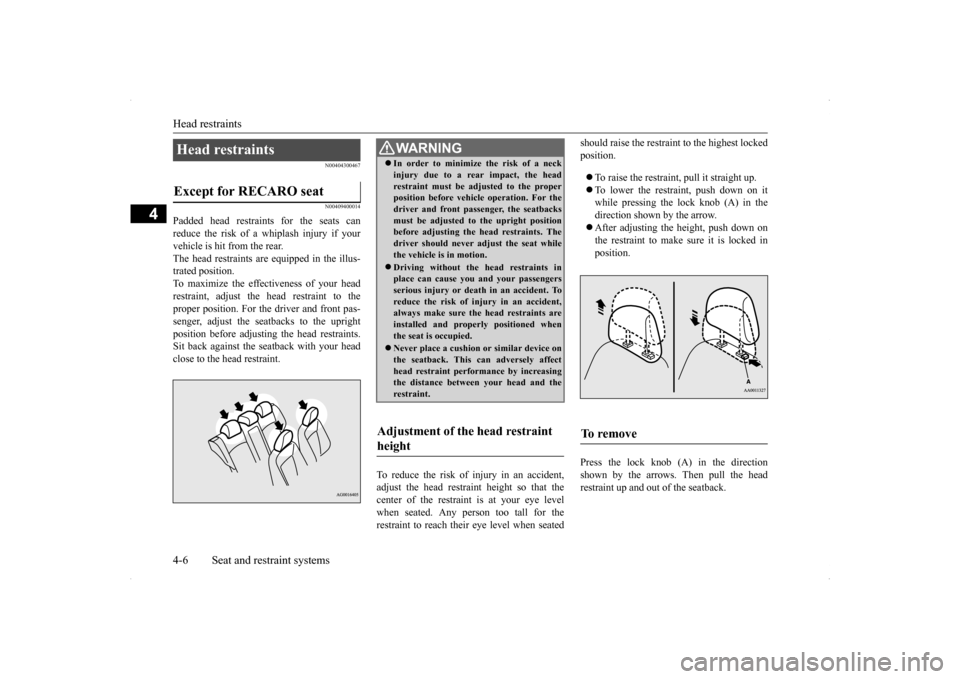
Head restraints 4-6 Seat and restraint systems
4
N00404300467 N00409400014
Padded head restraints for the seats can reduce the risk of a whiplash injury if yourvehicle is hit from the rear. The head restraints are equipped in the illus- trated position.To maximize the effectiveness of your headrestraint, adjust the head restraint to the proper position. For the driver and front pas- senger, adjust the seatbacks to the uprightposition before adjusting the head restraints. Sit back against the seatback with your head close to the head restraint.
To reduce the risk of injury in an accident, adjust the head restraint height so that thecenter of the restraint is at your eye level when seated. Any person too tall for the restraint to reach their eye level when seated
should raise the restraint to the highest locked position. To raise the restraint, pull it straight up. To lower the restraint, push down on it while pressing the lock knob (A) in thedirection shown by the arrow. After adjusting the height, push down on the restraint to make sure it is locked inposition.
Press the lock knob (A) in the direction shown by the arrows. Then pull the headrestraint up and out of the seatback.
Head restraints Except for RECARO seat
WA R N I N G In order to minimize the risk of a neck injury due to a rear impact, the head restraint must be adjusted to the proper position before vehi
cle operation. For the
driver and front passenger, the seatbacksmust be adjusted to the upright position before adjusting the head restraints. The driver should never adjust the seat whilethe vehicle is in motion. Driving without the head restraints in place can cause you and your passengers serious injury or death in an accident. To reduce the risk of injury in an accident,always make sure the head restraints are installed and properly positioned when the seat is occupied. Never place a cushion or similar device on the seatback. This can adversely affecthead restraint performance by increasing the distance between your head and the restraint.
Adjustment of the head restraint height
To remove
BK0200700US.bo
ok 6 ページ 2013年2月15日 金曜日 午後12時17分
Page 34 of 422
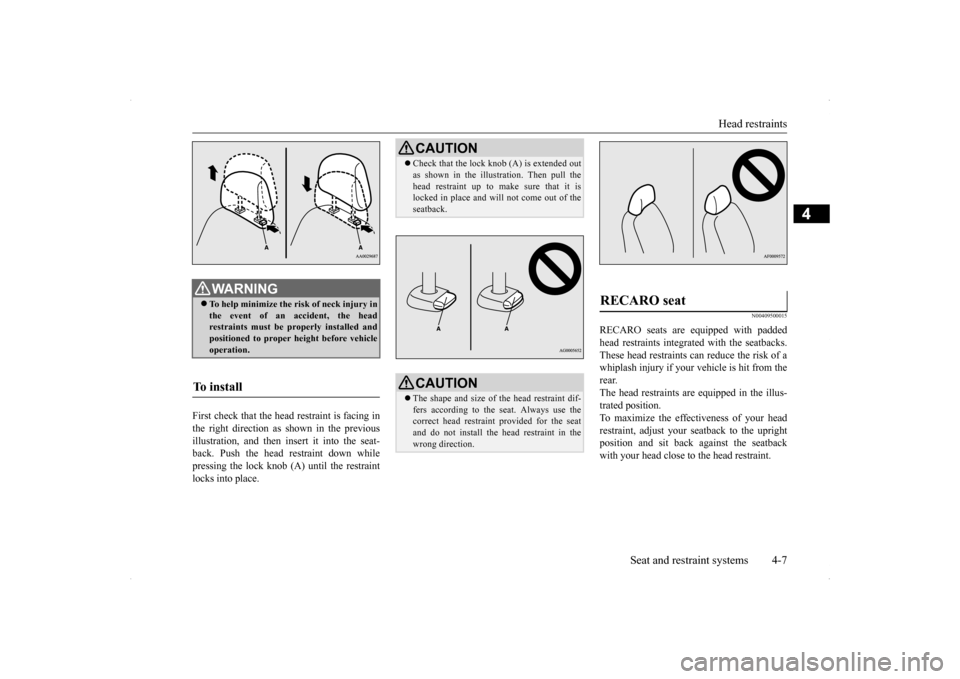
Head restraints
Seat and restraint systems 4-7
4
First check that the head restraint is facing in the right direction as shown in the previous illustration, and then insert it into the seat-back. Push the head restraint down while pressing the lock knob (A) until the restraint locks into place.
N00409500015
RECARO seats are equipped with paddedhead restraints integrated with the seatbacks. These head restraints can reduce the risk of a whiplash injury if your vehicle is hit from therear. The head restraints are equipped in the illus- trated position. To maximize the effectiveness of your headrestraint, adjust your seatback to the upright position and sit back against the seatback with your head close to the head restraint.
WA R N I N G To help minimize the risk of neck injury in the event of an accident, the head restraints must be properly installed andpositioned to proper height before vehicle operation.
To install
CAUTION Check that the lock knob (A) is extended out as shown in the illustration. Then pull the head restraint up to make sure that it is locked in place and will not come out of the seatback.CAUTION The shape and size of the head restraint dif- fers according to the seat. Always use the correct head restraint provided for the seatand do not install the head restraint in the wrong direction.
RECARO seat
BK0200700US.bo
ok 7 ページ 2013年2月15日 金曜日 午後12時17分
Page 35 of 422
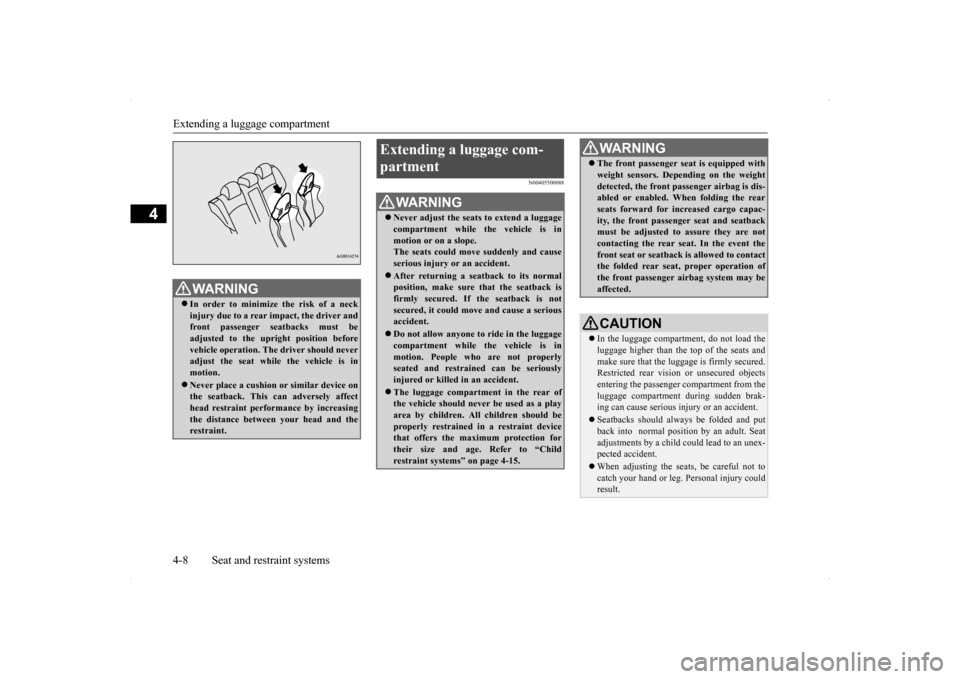
Extending a luggage compartment 4-8 Seat and restraint systems
4
N00405500088
WA R N I N G In order to minimize the risk of a neck injury due to a rear impact, the driver and front passenger seatbacks must beadjusted to the upright position before vehicle operation. The driver should never adjust the seat while the vehicle is inmotion. Never place a cushion or similar device on the seatback. This can adversely affect head restraint performance by increasing the distance between your head and therestraint.
Extending a luggage com- partment
WA R N I N G Never adjust the seats to extend a luggage compartment while the vehicle is in motion or on a slope. The seats could move suddenly and causeserious injury or an accident. After returning a seatback to its normal position, make sure that the seatback is firmly secured. If the seatback is not secured, it could move and cause a seriousaccident. Do not allow anyone to ride in the luggage compartment while the vehicle is in motion. People who are not properly seated and restrained can be seriouslyinjured or killed in an accident. The luggage compartment in the rear of the vehicle should never be used as a play area by children. All children should be properly restrained in a restraint devicethat offers the maximum protection for their size and age. Refer to “Child restraint systems” on page 4-15.
The front passenger seat is equipped with weight sensors. Depending on the weight detected, the front passenger airbag is dis- abled or enabled. When folding the rear seats forward for increased cargo capac-ity, the front passenger seat and seatback must be adjusted to assure they are not contacting the rear seat. In the event thefront seat or seatback is allowed to contact the folded rear seat, proper operation of the front passenger airbag system may beaffected.CAUTION In the luggage compartme
nt, do not load the
luggage higher than the top of the seats and make sure that the luggage is firmly secured.Restricted rear vision or unsecured objects entering the passenger compartment from the luggage compartment during sudden brak-ing can cause serious injury or an accident. Seatbacks should always be folded and put back into normal position by an adult. Seat adjustments by a child could lead to an unex- pected accident. When adjusting the seats, be careful not to catch your hand or leg. Personal injury could result.WA R N I N G
BK0200700US.bo
ok 8 ページ 2013年2月15日 金曜日 午後12時17分
Page 37 of 422

Seat belts 4-10 Seat and restraint systems
4
senger in the event of an accident. Always use the provided seat belts. Carefully review the following information for proper seat belt usage.
N00406201470
All seats are equipped with a seat belt whichuses one combined lap-and-shoulder belt withan emergency locking retractor. This system is designed to provide both com- fort and safety. It permits full extension and automatic retraction of the belts during nor-mal vehicle operation. A sensing device inside the belt retractor is designed to lock the retractor in the event of a sudden change inthe vehicle’s motion.
WA R N I N G To help reduce the risk of injury or death in an accident, seat belts and childrestraint systems must always be used. Refer to “Child restraint systems” on page 4-15 for additional information. Never use one seat belt for more than one person. Never carry more people in your vehicle than there are seat belts. Always adjust the seat
belt for a snug fit.
Always place the shoulder belt over your shoulder and across your chest. Never put it behind you or under your arm. Always wear the lap belt as low as possible across your hips, not around your waist. Never modify or alter the seat belts in your vehicle. To reduce the risk to the driver of serious injury or death during deployment of thedriver’s airbag, always properly wear the seat belt and adjust the driver’s seat as far back as possible while maintaining a posi- tion that still enables you to fully apply the pedals, easily control the steering wheel,and safely operate the vehicle.
To reduce the risk to a front seat passen- ger of serious injury or death from a deploying airbag, make sure the passenger always wears the seat belt properly, remains seated all the way back andupright in their seat, and moves the seat as far back as possible. Refer to “Supplemen- tal Restraint System (SRS) - airbag” onpage 4-23 for additional information. Never hold an infant or child in your arms or on your lap when riding in this vehicle even when you are wearing your seat belt. Never place any part of the seat belt youare wearing around an infant or child. Failure to follow these simple instructions creates a risk of serious injury or death toyour child in the event of an accident or sudden stop. Children 12 years old and under should always ride in the rear seat and be prop- erly restrained. This reduces their risk ofserious injury or death in an accident, especially due to a deploying front passen- ger airbag. Refer to “Child restraint sys-tems” on page 4-15 for additional information.WA R N I N G
Any child who is too small to properly wear a seat belt must be properly restrained in an appropriate child restraint system. Children 12 years old and under should be se
ated only in the
rear seat to reduce their risk of serious injury or death in an accident, especially from the deployment of a front passengerairbag. Infants MUST be placed in a rear-facing child safety seat and positioned in the rear seat. In the event of an accident, all seat belt assemblies, including retractors and attachment hardware, should be inspectedby an authorized Mitsubishi Motors dealer to determine whether replacement is necessary.
Seat belt instructions
WA R N I N G
BK0200700US.bo
ok 10 ページ 2013年2月15日 金曜日 午後12時17分
Page 38 of 422
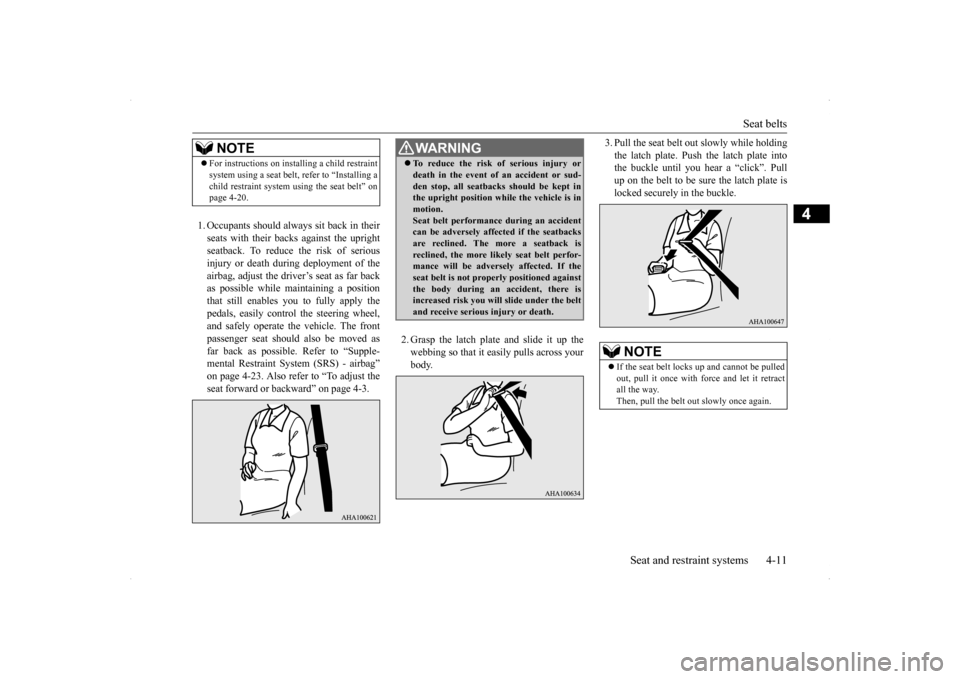
Seat belts
Seat and restraint systems 4-11
4
1. Occupants should always sit back in their seats with their backs against the upright seatback. To reduce the risk of seriousinjury or death during deployment of theairbag, adjust the driver’s seat as far back as possible while maintaining a position that still enables you to fully apply thepedals, easily control the steering wheel, and safely operate the vehicle. The front passenger seat should also be moved asfar back as possible. Refer to “Supple- mental Restraint System (SRS) - airbag” on page 4-23. Also refer to “To adjust theseat forward or backward” on page 4-3.
2. Grasp the latch plate and slide it up the webbing so that it easily pulls across yourbody.
3. Pull the seat belt out slowly while holding the latch plate. Push the latch plate into the buckle until you hear a “click”. Pull up on the belt to be sure the latch plate islocked securely in the buckle.
NOTE
For instructions on installing a child restraint system using a seat belt, refer to “Installing a child restraint system using the seat belt” on page 4-20.
WA R N I N G To reduce the risk of serious injury or death in the event of an accident or sud- den stop, all seatbacks should be kept in the upright position while the vehicle is in motion.Seat belt performance during an accident can be adversely affected if the seatbacks are reclined. The more a seatback isreclined, the more likely seat belt perfor- mance will be adversely affected. If the seat belt is not properly positioned againstthe body during an accident, there is increased risk you will slide under the belt and receive serious injury or death.
NOTE
If the seat belt locks up and cannot be pulled out, pull it once with force and let it retractall the way. Then, pull the belt out slowly once again.
BK0200700US.bo
ok 11 ページ 2013年2月15日 金曜日 午後12時17分
Page 40 of 422
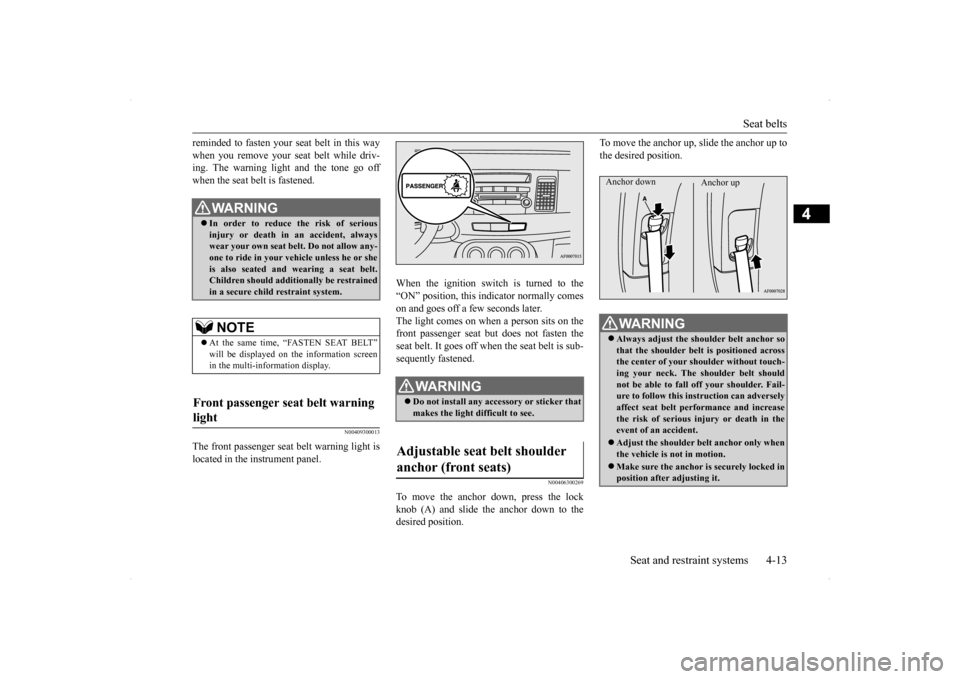
Seat belts
Seat and restraint systems 4-13
4
reminded to fasten your seat belt in this way when you remove your seat belt while driv- ing. The warning light and the tone go off when the seat belt is fastened.
N00409300013
The front passenger seat belt warning light islocated in the instrument panel.
When the ignition switch is turned to the “ON” position, this indicator normally comeson and goes off a few seconds later. The light comes on when a person sits on the front passenger seat but does not fasten theseat belt. It goes off when the seat belt is sub- sequently fastened.
N00406300269
To move the anchor down, press the lock knob (A) and slide the anchor down to the desired position.
To move the anchor up, slide the anchor up to the desired position.
WA R N I N G In order to reduce the risk of serious injury or death in an accident, alwayswear your own seat belt. Do not allow any- one to ride in your vehicle unless he or she is also seated and wearing a seat belt.Children should additionally be restrained in a secure child restraint system.NOTE
At the same time, “FASTEN SEAT BELT” will be displayed on the information screen in the multi-information display.
Front passenger seat belt warning light
WA R N I N G Do not install any accessory or sticker that makes the light difficult to see.
Adjustable seat belt shoulder anchor (front seats)
WA R N I N G Always adjust the shoulder belt anchor so that the shoulder belt is positioned acrossthe center of your shoulder without touch- ing your neck. The shoulder belt should not be able to fall off your shoulder. Fail-ure to follow this instruction can adversely affect seat belt performance and increase the risk of serious injury or death in theevent of an accident. Adjust the shoulder belt anchor only when the vehicle is not in motion. Make sure the anchor is securely locked in position after adjusting it.Anchor down
Anchor up
BK0200700US.bo
ok 13 ページ 2013年2月15日 金曜日 午後12時17分
Page 41 of 422
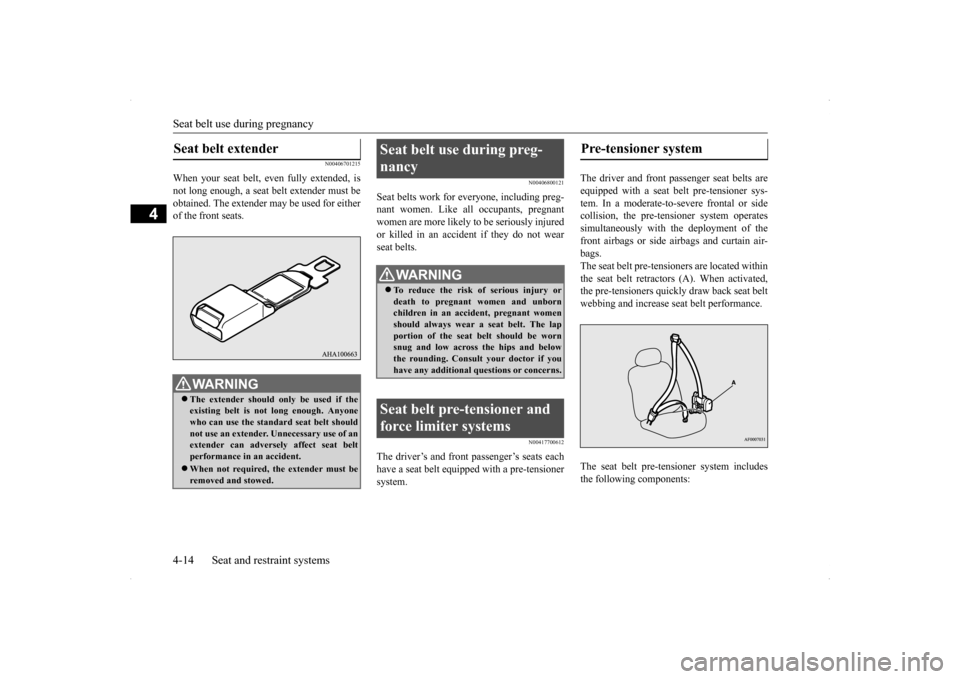
Seat belt use during pregnancy 4-14 Seat and restraint systems
4
N00406701215
When your seat belt, even fully extended, is not long enough, a seat belt extender must beobtained. The extender may be used for either of the front seats.
N00406800121
Seat belts work for ev
eryone, including preg-
nant women. Like all occupants, pregnantwomen are more likely to be seriously injured or killed in an accident if they do not wear seat belts.
N00417700612
The driver’s and front passenger’s seats eachhave a seat belt equipped with a pre-tensioner system.
The driver and front passenger seat belts are equipped with a seat belt pre-tensioner sys-tem. In a moderate-to-severe frontal or side collision, the pre-tensioner system operates simultaneously with the deployment of thefront airbags or side airbags and curtain air- bags. The seat belt pre-tensioners are located withinthe seat belt retractors (A). When activated,the pre-tensioners quickly draw back seat belt webbing and increase seat belt performance. The seat belt pre-tensioner system includes the following components:
Seat belt extender
WA R N I N G The extender should only be used if the existing belt is not long enough. Anyonewho can use the standard seat belt should not use an extender. Unnecessary use of an extender can adversely affect seat beltperformance in an accident. When not required, the extender must be removed and stowed.
Seat belt use during preg- nancy
WA R N I N G To reduce the risk of serious injury or death to pregnant women and unbornchildren in an accident, pregnant women should always wear a seat belt. The lap portion of the seat belt should be wornsnug and low across the hips and below the rounding. Consult your doctor if you have any additional questions or concerns.
Seat belt pre-tensioner and force limiter systems
Pre-tensioner system
BK0200700US.bo
ok 14 ページ 2013年2月15日 金曜日 午後12時17分
Page 50 of 422

Supplemental Restraint System (SRS) - airbag
Seat and restraint systems 4-23
4
Regularly check your seat belt buckles and their release mechanisms for positive engage- ment and release of the latch plate. Check the retractors for automatic locking when in theAutomatic Locking Retractor function. The entire seat belt assembly should be replaced if the webbing shows any obvious cuts, tears, increase in thickness in any sec-tion of the webbing from broken fibers, or severe fading from sunlight. All of these con- ditions indicate a weakening of the belt,which may adversely affect seat belt perfor-mance in an accident.
N00407701733
This vehicle is equipped with a SupplementalRestraint System (SRS), which includes air-bags for the driver and passengers.
The SRS front airbags are designed to supple- ment the primary protection of the driver and front passenger seat belt systems by provid- ing those occupants with protection againsthead and chest injuries in certain moderate to severe frontal collisions. The SRS front airbags, together with sensorsat the front of the vehicle and sensors attached to the front seats, form an advanced airbag system. The SRS driver’s knee airbag is designed to supplement the primary protection of thedriver’s seat belt system. It can reduce the forward movement of the driver’s lower legs and provide increased overall body protectionin certain moderate to severe frontal colli- sions. The SRS side airbags and the curtain airbags are also designed to supplement the seat belts.The SRS side airbags provide the driver and front passenger with protection against chest injuries by deploying the bag on the sideimpacted in moderate to severe side impact collisions. The SRS curtain airbags provide the driver and passengers on the front seatand rear outboard seat with protection against head injuries by deploying a bag on the side impacted in moderate to severe side impactcollisions.
The SRS airbags are NOT
a substitute for use
of the seat belts. For maximum protection in all types of accidents, seat belts must ALWAYS be worn by everyone who drives orrides in this vehicle (with infants and small children in an appropriate child restraint sys- tem in the rear seat, and older children buck-led in the rear seat). Refer to “Child restraint systems” on page 4-15.
WA R N I N G Do not attempt to repair or replace any part of the seat belt assemblies. This work should be done by an authorized Mitsubishi Motors dealer. Failure to havean authorized Mitsubishi Motors dealer perform the work could reduce the effec- tiveness of the belts and could result in aserious injury or death in an accident.
Supplemental Restraint Sys- tem (SRS) - airbag
WA R N I N G IT IS VERY IMPORTANT TO ALWAYS WEAR YOUR SEAT BELT PROPERLY EVEN WITH AN AIRBAG.• Seat belts help keep the driver and pas-sengers properly positioned. This reduces the risk of injury in all collisions,and reduces the risk of serious injuries or death when the airbags inflate. During sudden braking just before a col-lision, an unrestrained or improperly restrained driver or passengers can move forward into direct contact with, orwithin close proximity to, the airbag when it begins to inflate. The beginning stage of airbag inflation isthe most forceful and can cause serious injuries or death if the occupant comes in contact with the airbag at this time. • Seat belts reduce the risk of injury inrollovers, rear impact collisions, and in lower-speed frontal collisions, because the airbags are not designed to inflate inthose situations.
BK0200700US.bo
ok 23 ページ 2013年2月15日 金曜日 午後12時17分